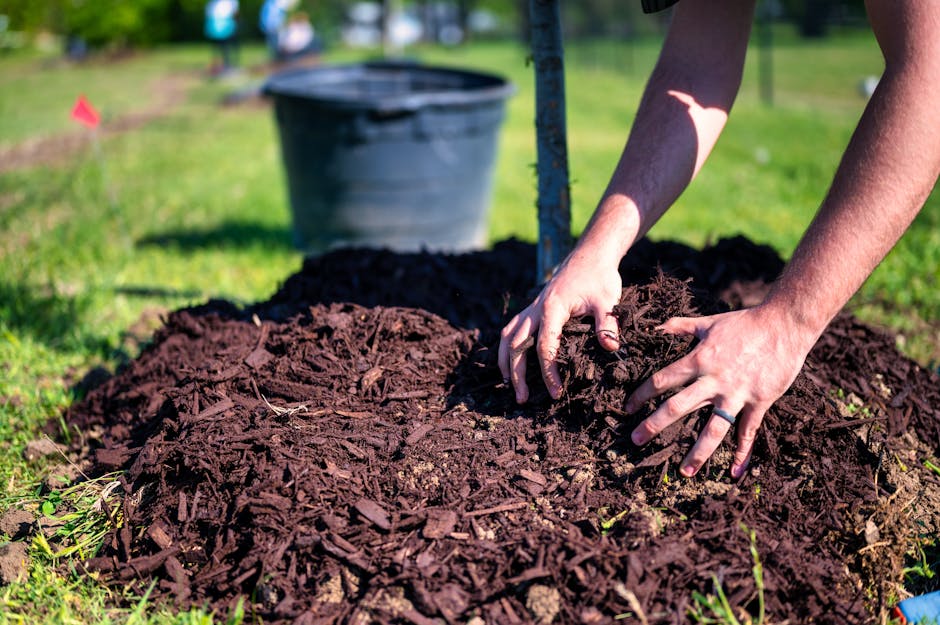 Gardners’ Mulch: An Essential for Beautiful Summer Gardens
Gardners’ Mulch: An Essential for Beautiful Summer Gardens
When enhancing your garden’s beauty and health for the summer, gardeners’ mulch is indispensable. Mulch does much more than make your garden look neat; it acts as a shield, protecting your soil and plant roots from the sweltering summer heat and preventing moisture loss during those long, hot days. Here’s why incorporating mulch into your summer gardening routine is essential:
- Retains soil moisture, reducing the need for frequent watering.
- Suppresses weeds, which compete with your plants for nutrients.
- Regulates soil temperature, protecting roots from extreme heat.
Mulch is not just beneficial; it’s a necessity for maintaining a vibrant and sustainable garden through the challenging summer months.
For expert advice on the right mulch for your garden, trust Borst Landscape & Design. Our team is equipped to transform your garden into a thriving outdoor oasis. Call us at (201) 785-9400 or reach out online today!
Why Use Gardener’s Mulch?
Mulching is more than just a gardening practice; it’s a strategic method to enhance and protect your garden, especially during the harsh summer months. Let’s explore why mulch is so beneficial and how it contributes to a healthier garden.
Benefits of Mulching
- Soil Moisture Conservation: Mulch helps retain water in the soil by reducing evaporation. This is crucial during hot weather when water can quickly evaporate.
- Weed Suppression: By covering the soil, mulch prevents weed seeds from getting the sunlight they need to germinate, thus keeping your garden tidy and less labor-intensive.
- Soil Temperature Regulation: Mulch acts as an insulating layer, keeping the soil cooler on hot days and providing some warmth on cooler nights. This stability is vital for plant health.
Types of Gardener’s Mulch
- Organic Mulches: This type includes materials like shredded bark, straw, and leaf mold. Organic mulches enrich the soil as they decompose, adding nutrients that plants need to thrive.
- Inorganic Mulches: Materials such as black plastic and landscape fabric fall into this category. They are particularly good at suppressing weeds and retaining moisture but don’t improve soil structure or fertility.
When to Apply Gardener’s Mulch
- Spring Mulching: Applying mulch in spring helps to warm the soil, allowing you to plant earlier. It also retains moisture from spring rains.
- Fall Mulching: This helps protect plant roots from winter cold and adds nutrients to the soil as organic mulch breaks down.
- Mulching in Hot Weather: Essential for protecting roots from extreme heat and keeping the soil moist during dry spells.
Mulching is not just about making gardens look neat; it’s about creating a healthier environment for your plants to flourish. By choosing the right type of mulch and applying it at the optimal time, you can significantly enhance the vitality of your garden.
How to Properly Apply Gardener’s Mulch
Proper mulching is crucial for the health and appearance of your garden. Below, we’ll guide you through preparing your garden for mulch and the step-by-step process of applying it effectively.
Preparing Your Garden for Mulch
Soil Preparation:
Before applying any gardener’s mulch, prepare the soil. This involves cleaning the area by removing any debris, old mulch, or residues that might block moisture and nutrients from reaching the plant roots.
Removing Weeds:
Ensure that all weeds are thoroughly removed before mulching. Weeds can compete with your plants for nutrients and water. Removing them helps to ensure that your mulch provides maximum benefits.
Assessing Soil Type
Understanding your soil type—whether it’s clay, sandy, or loamy—can influence how much and what type of mulch you should use. For instance, sandy soils benefit from organic mulches. Loamy soils, being well-balanced, can handle a variety of mulches, while clay soils might need lighter options to avoid compaction.
Professional landscapers, like those at Borst Landscape & Design, can assess your soil type and recommend the best mulch for your garden. They have the expertise and the right equipment to ensure your garden thrives.

Step-by-Step Mulching
Layering:
Apply a layer of mulch around your plants and garden beds. The recommended depth is 2 to 3 inches of mulch to effectively suppress weeds and retain soil moisture without suffocating plant roots. Be cautious not to exceed this as too much mulch can lead to excess moisture retention and root rot.
Around Plants:
When mulching around plants, leave a small gap around the stem or trunk. This space prevents moisture buildup around the plant base, which can lead to decay or fungal diseases.
Near Tree Trunks:
For trees, avoid what is known as ‘volcano mulching,’ where mulch is piled high against the tree trunk. Instead, keep mulch about 6 to 12 inches away from the trunk to prevent issues with rot and provide a healthy growing environment.
Avoiding Common Mistakes:
- Do not use too fine or too dense a mulch as it can prevent water and air from penetrating the soil.
- Avoid letting mulch touch plant stems or tree barks directly to prevent rot.
- Be mindful of the material used; certain mulches like black plastic may not be suitable for all garden types due to their non-permeable nature.
By following these guidelines, you can ensure that your mulch application is effective and beneficial for your garden. Proper mulching not only enhances soil health and moisture retention but also gives your garden a neat, tidy appearance.
For expert guidance and professional mulching services, contact Borst Landscape & Design at (201) 785-9400. Our team is equipped to handle all your garden needs, ensuring your landscape is beautiful, thriving, and healthy.
Enhancing Your Garden’s Health with Mulch
Mulch is more than just a garden accessory; it’s a vital component for maintaining a healthy and vibrant garden, especially during the challenging summer months. Let’s explore how mulch can transform your garden into a robust, flourishing oasis.
Mulch and Plant Health
Protecting Plant Roots
During the hot summer months, the soil can heat up to temperatures that are harmful to plant roots. Mulch acts as an insulating layer, protecting roots from extreme heat and helping to maintain a stable soil temperature. This protection is crucial for the survival and health of your plants.
Disease Prevention
A layer of mulch helps prevent soil splash, which is a common way for fungal and bacterial diseases to spread to plant leaves. By keeping the soil in place, mulch reduces the risk of these diseases, keeping your plants healthy and attractive.
Growth Consistency
Mulch helps to regulate the moisture levels in the soil, ensuring that plants receive a consistent amount of water. This consistent moisture availability helps plants to grow more uniformly and reduces stress that can stunt growth or lead to poor health.
Microclimate Stabilization
Mulch creates a microclimate within the soil by moderating temperature fluctuations and maintaining moisture levels. This stable environment allows plants to thrive, even in less-than-ideal weather conditions.
Eco-Friendly Mulching
Organic Matter
Organic mulches such as wood chips, straw, or leaf litter break down over time, adding valuable organic matter to the soil. This decomposition process enriches the soil and feeds the microorganisms that are essential for a healthy soil ecosystem.
Sustainability
Using organic mulches contributes to a sustainable gardening practice. These materials are often sourced from garden waste or local wood, reducing the need for synthetic fertilizers and enhancing the overall sustainability of your garden.
Supporting Microorganisms
Mulch provides a habitat for beneficial microorganisms by supplying them with food and a moist environment. These microorganisms play a critical role in decomposing organic matter, cycling nutrients, and improving soil structure, which in turn supports plant health.
By incorporating gardener’s mulch into your landscape, you are not only beautifying your space but also investing in the long-term health of your garden. Mulch is an essential tool for any gardener looking to protect their plants, enhance growth, and contribute to a more sustainable environment.
For Expert Gardener’s Mulch, Call Borst
As we’ve explored throughout this article, the benefits of using gardener’s mulch are extensive and impactful. From regulating soil temperature to maintaining moisture levels and suppressing weeds, mulch is a powerhouse in promoting healthy garden ecosystems. During the hot summer months, it proves invaluable in protecting plant roots from extreme temperatures and retaining soil moisture, which can be particularly challenging during periods of intense heat.
At Borst Landscape & Design, we understand the critical role that proper mulching plays in the health and aesthetics of your garden. Our services are designed to cater to all your garden needs, ensuring that your outdoor space not only thrives but also contributes to an environmentally sustainable landscape. We offer personalized mulching solutions tailored to the specific needs of your garden, utilizing high-quality materials that complement our comprehensive range of landscaping services.
Call us today at (201) 785-9400 for a consultation or to schedule a professional mulching service. Let us help you enhance your garden’s health and beauty with the right mulching techniques. Discover more about our services and how we can assist you in achieving the perfect summer garden by visiting our mulch options page. Your vibrant, thriving garden awaits!
